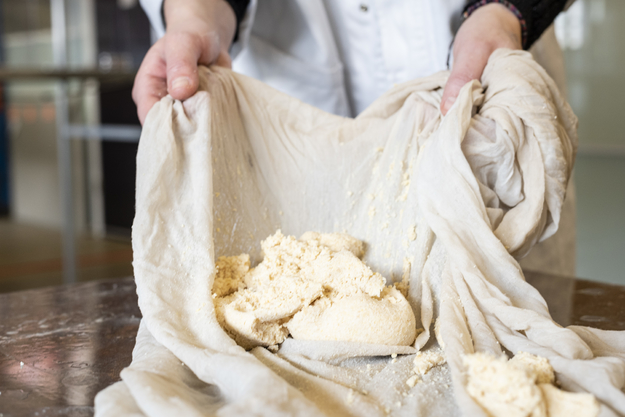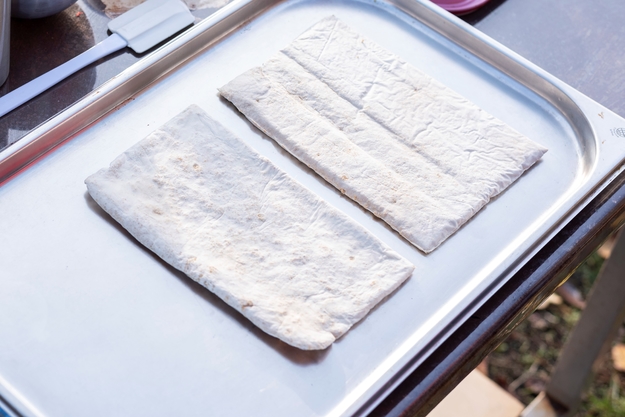So, what is okara? Okara is the by-product of soy milk and tofu production. It is the soy bean pulp – meaning all the insoluble fibres that are left over from blending and pressing out the soy milk.
This by-product is commonly treated as a waste product and sent to animal feed industries. Okara is a very low-cost product, yet with surprisingly high nutritional value that we don't have to waste! Okara is high in protein as it carries 15% of the protein in the soy beans. Okara is low in calories and saturated fats. It is also a good source of Calcium, Potassium, Phosphorus and Iron and is high in dietary fibre. The fibre and carbohydrate composition in okara both contribute to intestinal health and have been suggested to assist in the prevention of intestinal cancer.
Additionally, fermenting the okara increases its nutritional value. For instance, fat content significantly decreases while protein content increases. Fermentation also increases the antioxidant acitivity - and so, okara tempeh is a great way to recycle the soybean leftovers and transform them into a nutritious food product. If you are familiar with making tempeh at home, this should be very easy as it is a similar process. If not, don't worry, these guided steps will help you grow successful okara tempeh at home!
Tip before you begin: Make sure you are working in a clean and sterile space. This avoids any contamination and ensures the tempeh has the best growing conditions!
Okara Tempeh - recipe for 2
For 1 batch you need:
- 200g fresh Okara
- 1 tsp Tempeh Starter (Rhizopus oligosporus)
- 4 ml White vinegar
- Oven / Dehydrator
- Pressure cooker / Steamer
- Ziplock bags
1. Making okara: Okara is the remaining soy bean pulp after pressing out the soy milk - therefore it is produced when making tofu or soy milk! Check out the recipe here.
2. Drying: It is advisable to dehydrate the okara to reduce the moisture content slightly. This way the tempeh can grow much better. If you have a dehydrator, spread the okara evenly on baking paper and leave it in for 1 hour at 50C. If you are using an oven, put it on the lowest temperature setting and leave the door slightly open for 1 hour. This allows for ventilation and dries the okara nicely.
An alternative to this is to warm the okara in a pan for 30 minutes, reaching 70-90C while stirring to avoid sticking. Once it has small particle sizes and is lose, remove and stir until it cools.
3. Cooking: Even though fresh okara can be used without further cooking, this is needed to sterilise the okara. Cooking impedes any other micro-organisms from growing and competing with the tempeh. The okara is placed in a metal bowl or container and pressure cooked for 10 minutes. If you are using a steamer, steam the okara for 15 minutes.
4. Cooling: After the okara has been sterilised, place on clean flat trays or chopping boards to cool. The okara should reach body temperature or lower - higher temperatures would kill the Rhizopus culture.
5. Adding vinegar: Reducing the pH to be within 4.5 and 5.3 is important for healthy tempeh to grow. Add 4ml vinegar per 200g okara and mix well in a bowl.
6. Inoculation: Mix 1 tsp tempeh starter with your okara. Mix with a clean spoon and make sure to evenly distribute the starter.
7. Moulding: Add the mixture to the ziplock bags using clean utensils. Punch small holes in the bags about 2cm apart. This is essential for the tempeh to have enough oxygen to grow. However, too much oxygen could inhibit the growth of the Rhizopus so make sure the holes aren't too big. A clean needle or saté-sticks can work perfectly. Spread the mixture evenly in the bag.
8. Incubation: Place the bag inside your dehydrator or oven. The tempeh will grow best between 27C and 31C. Place your tempeh inside and let it grow for 28-50 hours. The time it takes to grow depends on the temperature. For okara, a constant temperature in the lower ranges, such as 27C, works best as it avoids sporulation, however takes a little longer.
Finally, enjoy your delicious homemade okara tempeh! A great meat substitute with amazing nutritional properties.
Some tips:
- Make sure to cook the tempeh before you eat it. A nice way to prepare okara tempeh is frying it in sunflower oil - yum!
- If you notice sporulation, which is black or grey colour on your tempeh, don't fret! This isn't harmful, the tempeh is still good to consume.
- Okara tempeh can be stored in the fridge for up to 3 days or frozen for longer storage.
- The best indicator for spoiled tempeh is the smell - a strong, sour odour will be present if your tempeh has gone bad.

